Student Notable
Speculative Design Award
Core77 Design Awards 2023
CBDCs for SDGs
CBDCs for SDGs is a master's thesis exploring 'central bank digital currency' (CBDCs), an emerging technology currently researched by 90% of the world's central banks. Explained simply, one could think of it as a digital alternative to the physical cash produced by central banks, a public alternative to the electronic money in our private banks, or as a crypto-inspired national digital currency. Through strategic design, the project shows how CBDCs could enable new kinds of policies to achieve 'the sustainable development goals' (SDGs) in Norway.
The project delivery is an alternative strategic vision consisting of design examples showing the breadth of possibilities as well as four strategic principles for how the Norwegian Central Bank could facilitate for a sustainable transition. The examples are carbon rations, long term contracts, local currencies, and volunteer currency.
The thesis has inserted the field of design into a complex domain where design until now has never played a strategic role. By collaborating with The Norwegian Central Bank, Rethinking Economics, and experts in fintech, public sector innovation and policy, the project connects concerns regarding carbon emissions, climate justice, consumer culture, and industrial resource use, issues outside the bounds of conventional monetary policy, with questions of radical digitization and holistic policy making.
The results show a new and understudied direction for CDBCs and central bank that transcends current discourse between conventional and ecological economists. The project takes instead a holistic view on innovation, digitization and collaboration in the Norwegian monetary system and sustainable development.
 Project delivery
Project deliveryThe thesis delivers an alternative strategic vision for central bank digital currencies. The vision consists of four alternative strategic principles demonstrated through four design examples.
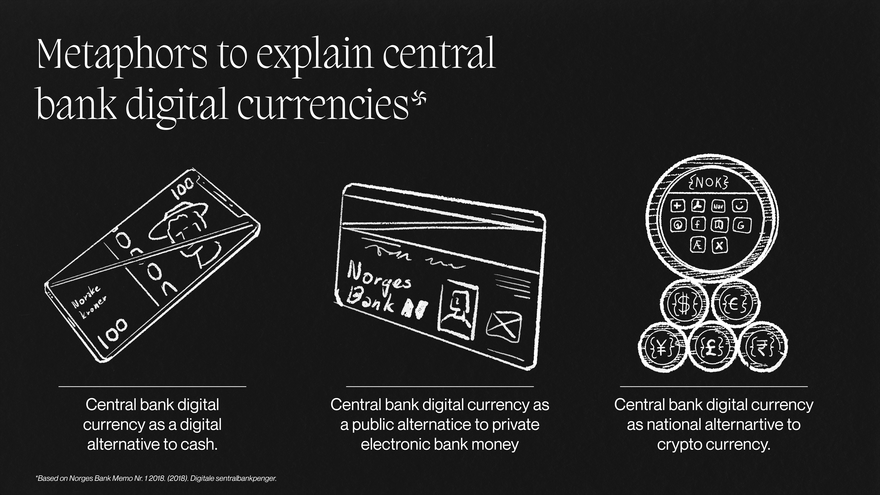 Explaining CBDCs
Explaining CBDCsThe world's central bank are still researching exactly what central bank digital currencies should be and how it should work. Here are three metaphors that each illustrates possible qualities.
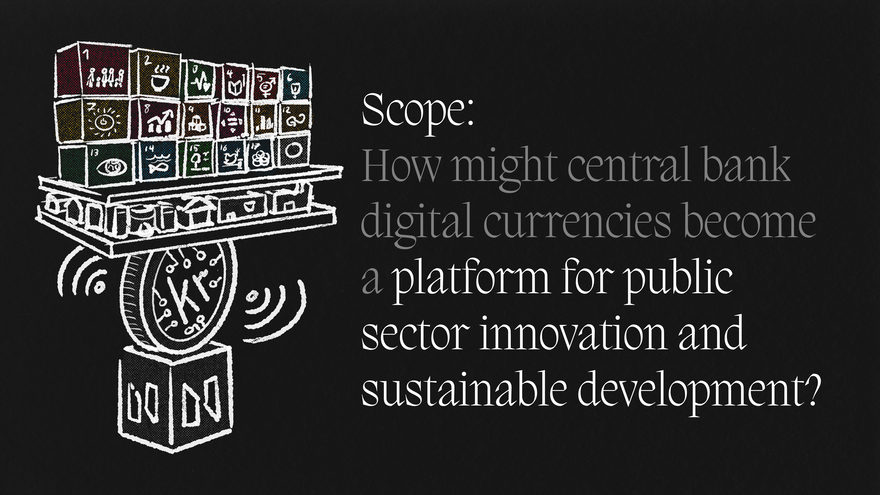 Project scope
Project scopeExploring CBDCs as a platform means considering what other needs and issues within the public sector it could solve.
 Design example I
Design example IWhat if we used CBDCs to implement a more fair emission policy?
 Design example II
Design example IIWhat if we used CBDCs to create systems for a more long term and sustainable economy?
 Design example III
Design example IIIWhat if we used CBDCs to allow for local currencies strenghtening local value chains?
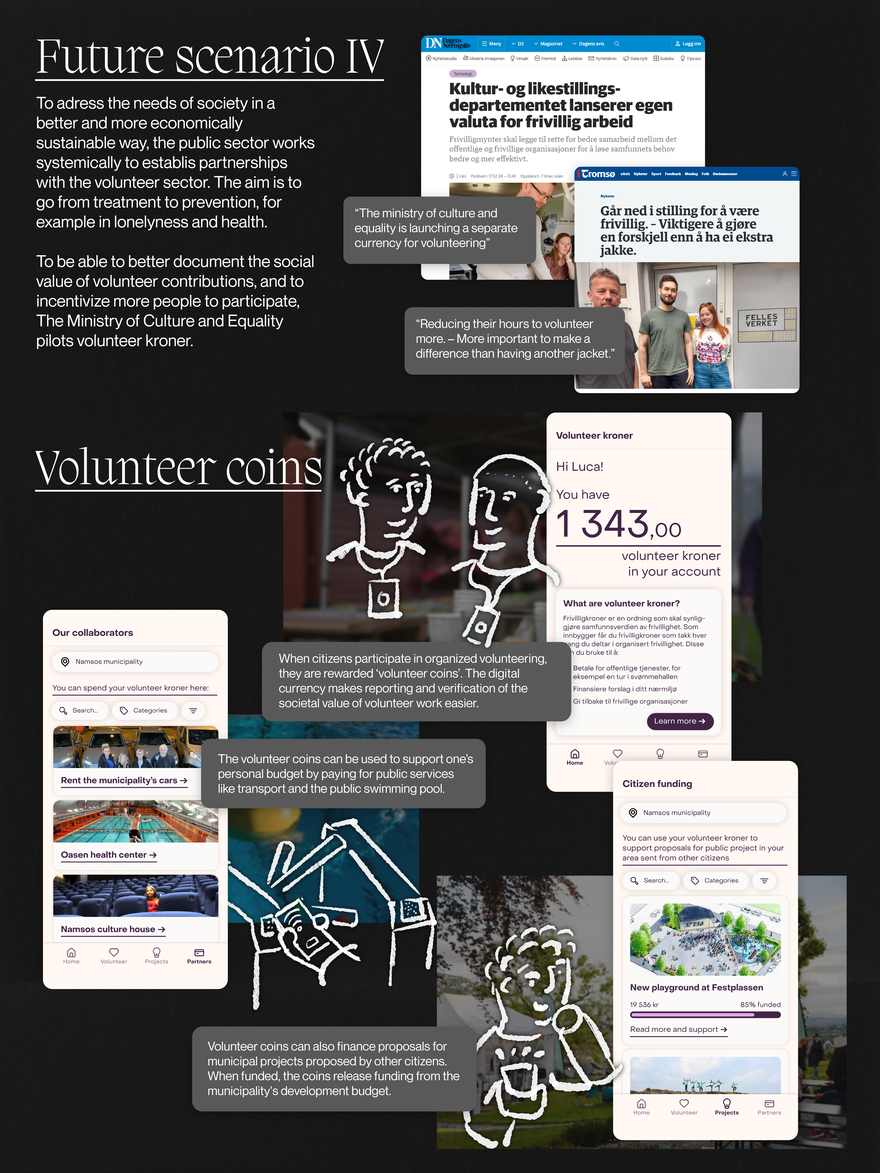 Design example IV
Design example IVWhat if we used CBDCs to replace consumer culture with more meaningful everydays and relationships?
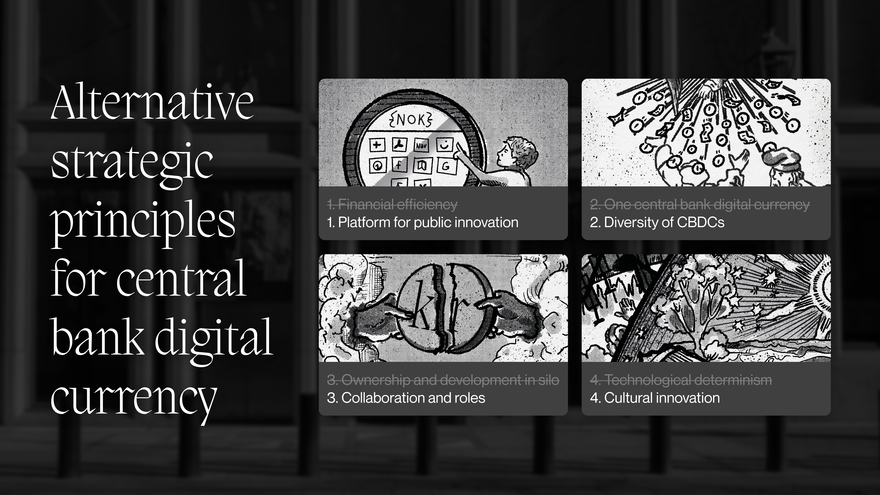 Alternative strategic principles
Alternative strategic principlesThe principles are formulated to flip or challenge the central bank's approach to CBDCs today. These principles would be required to enable the design examples.
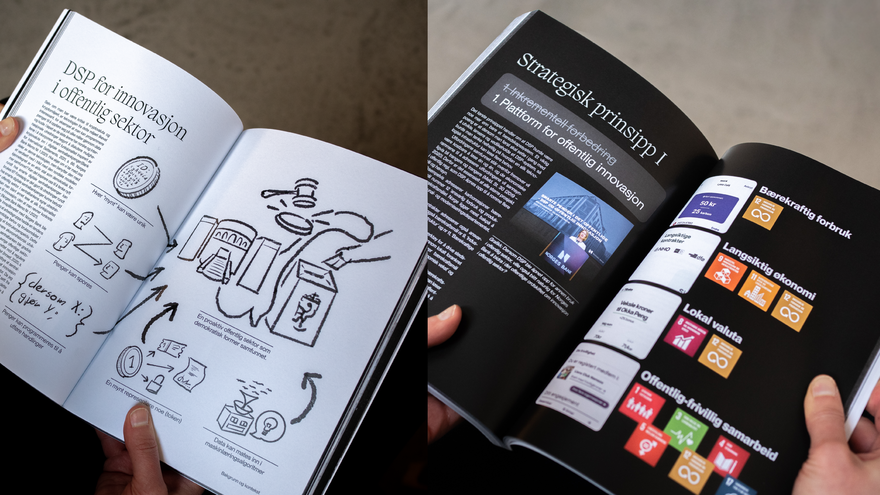 Written report
Written reportThe written report was designed to be an object of intrigue, drawing the attention of busy central bankers.
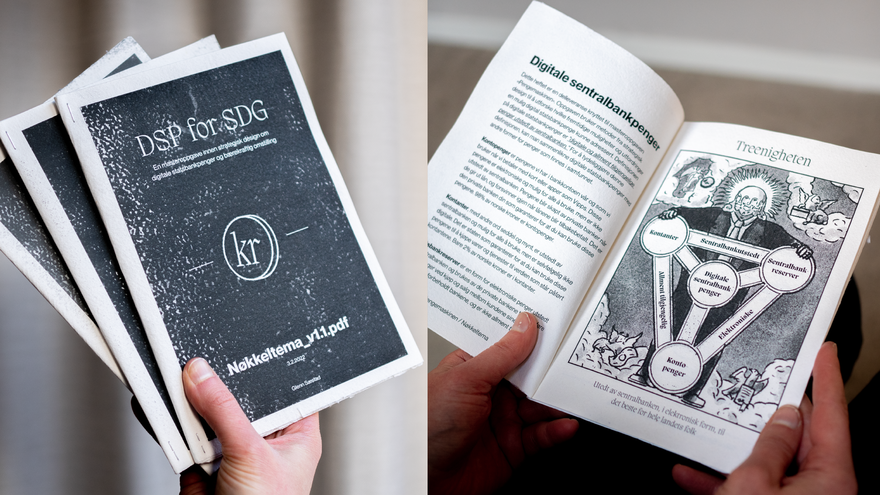 Key insight booklet
Key insight bookletTo work creatively during my research phase, I synthesized insights into a small booklet containing key questions and reflections that could inspire new ideas for CBDCs.
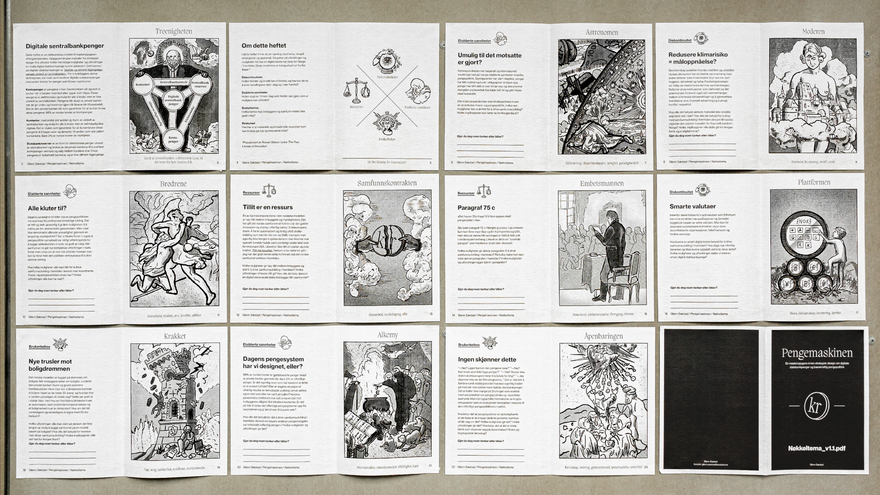 Overview of key insights
Overview of key insightsUsing the visual language of tarot and esoteric symbolism allowed me to communicate my work to empirically rigorous bankers as specualtive musing about future possibilites, and not as hard science set in stone.
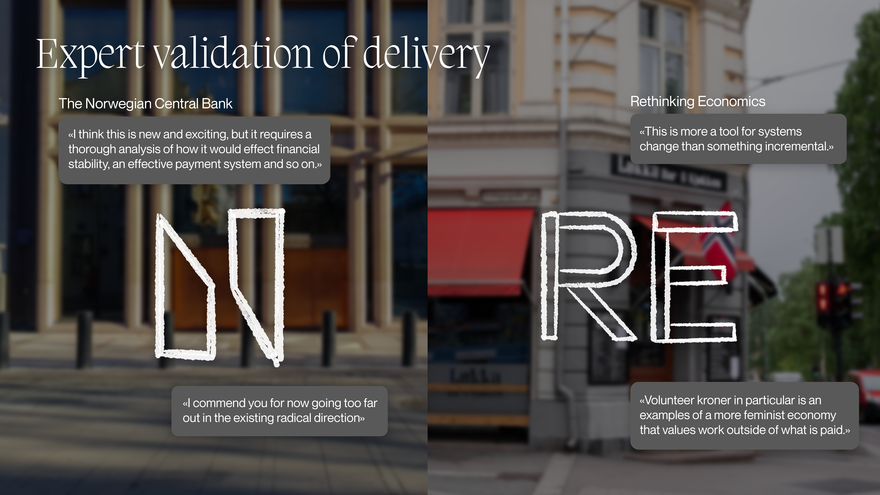 Expert validation
Expert validationTo gather insight into the strategic and systemic value of the design examples, I used domain experts within conventional and radical economics to test my prototypes and sketches.
Reframing central bank digital currency around public sector innovation and the sustainable development goals
90% of the world's central banks are researching how CBDCs could make the monetary system more efficient. Simultaneously, the UN panel on climate change calls for cross-sectoral action with all possible means. Thirdly, to the Norwegian government, public sector innovation is "one of our main strategies to solve the big societal challenges". The thesis thus aimed to act as a policy white paper on behalf of The Norwegian Central Bank exploring innovation opportunities concerning CBDCs and SDGs. As the central bank's working group on the topic had no prior knowledge about design methods, demonstrating the value of design for central banking was also an important goal.
Using design to connect differing perspectives, domains and issues
Throughout the design process I was in continuous dialogue with the central bank and 24 experts in economics, fintech, and public policy, with synthesis and sketching in-between. A key insight was learning that 'political independence' has been an important central banking principle for over fifty years. The principle says that the central bank should not let it be influenced by or involve itself in other political domains. Since the central bank isn't under control by the elected government, conventional economists argue that if bureaucrats in the central bank were to take action to change society, for example a sustainable transition, then this would be undemocratic. Thus, the central bank's current mandate focuses solely on financial stability and efficiency. However, it seems like we are now standing in front of a paradigm shift concerning central banking and sustainability. We see more and more connections between the effects of climate change and the financial stability in Norway, which falls under the central bank's current mandate.
Design futures exploring policy and innovation opportunities
I summarized my insights into a set of future scenarios asking, "What if all of public sector could build services on top of a CBDC infrastructure?" This exercise resulted in 14 concepts, which the experts rated and discussed. The delivery, an alternative strategic vision, consists of the most interesting concepts challenging the central bank's current approach to CBDC.
Carbon rations: A rationed currency system for fair consumption.
This example challenges the current effort to reduce carbon emissions by carbon taxes and carbon credits. The issue here is that the world's richest 10%, who are responsible for over 50% of the world's total carbon emissions, can afford to continue as before while the poorest are hit hardest by carbon taxes such as higher fuel and electricity costs.
Carbon rations asks, what if we moved from a utilitarian ethical mindset to a Kantian one, where a fair emission policy is that no one person should emit more than anyone else could? Carbon rations is a parallel currency where each citizen gets an equal share of the national emission budget, which they use to pay for goods and services along with "regular money" according to price and carbon footprint.
People are free to spend as much money they have and want as long as they purchase goods and services with low enough total carbon emissions. The effect of this is that the poorest with the lowest amount of consumption notice little to these limits, while the richest need to make huge changes to their consumption habits.
Long-term contracts: Locking funds from public construction procurements until milestones throughout buildings' life cycles
The construction industry is often called the 40%-industry, as it contributes 40% of the world's material consumption, electricity consumption and climate gas emissions. This example asks, what if we could give the industry a real incentive to become sustainable by relating their profits to the real use value of building throughout buildings' lifespans?
With Long-Term Contracts, funds in public construction projects are transferred to contractors at project start, but locked until set milestones over the planned 60 year building lifespan. In this way all parties can trust a payment plan spanning over half a decade. Should the building degrade in quality and usefulness faster than planned, the contractors lose their rights to access the rest of the money. The contractors now have a strong incentive to make sure that the building is user friendly, flexible, and easy to maintain throughout the whole life cycle. They now must do a much better job at ensuring there is a real demand for a new building, and new financial products taking security in future payments from long term contracts are developed.
Local currency: The opportunity for municipalities to launch their own currencies with limitations and benefits based on local needs
Spending money with a local business generates 1,5 to 2 times more jobs locally compared to spending it with large corporations. Increased attention to local value creation and circulations makes rural municipalities in Norway request pilots for local currencies, inspired by examples in Europe and Great Britain. Dialogue with existing local currency initiatives uncovers that a shared challenge has been securing enough resources to develop the underlying technological infrastructure. The CDBC platform is therefore developed to support money with geographic limitations at scale.
The local currency works by letting citizens exchange "normal money" for "local money" giving them a small percentage exchange-in bonus. The local money can only be spent on local businesses and exchanging them back to normal money incurs a fee higher than the exchange-in bonus. This system incentivizes keeping money local and by re-spending them on other local suppliers.
Volunteer currency: A currency for public-volunteer collaboration
The last example supports the government's existing initiative to deliver citizen services in a better and more economically sustainable way by collaborating more systemically with the volunteer sector. The aim is to go from treatment to prevention, for example in loneliness and health issues. To be able to better document the societal value of volunteering, and to incentivize more people to participate, The Ministry of Culture and Equality pilots volunteer coins.
With volunteer coins, organized volunteers get coins as a reward to highlight the societal value of coming together to sing in choirs, play badminton, fix cars and much more. The coins can be spent on public services such as visits to the public swimming pool, transport, and public canteens. The volunteer coins can also be spent on 'citizen budgeting', where citizens spend their coins voting on and funding public projects in their area suggested by other citizens. The municipality now has an overview of active community members they can invite as representatives in participative planning processes through the volunteer coin system.
The effect of the volunteer coins, is that citizens experience that they can work a bit less, contribute more for others and experience just as much or more happiness. Reduced income and more a meaningful everyday leads to a reduction in consumption, since the deeper social needs are satisfied through social belonging. At the same time the volunteer coins covers access to basic services, such as transport.
Designing examples to develop and demonstrate strategic principles
The delivery also includes strategic principles based on insights from designing the examples. The principles call for better collaboration with other parts of government, so that they can develop innovative and holistic policies. This will enable a diversity of central bank currencies for different goals, managed by different parts of government.
Potential value creation
This thesis is not about the design examples themselves but an under-researched direction for CBDCs challenging the central bank's approach to innovation. Adopting the SDGs would generate great impact outside of the central bank. The public sector would gain a new digital infrastructure for achieving the SDGs, creating value for citizens by transitioning into a more sustainable and stable society faster. The central bank could thus live up to society's expectations of contributing to sustainable development without breaking the principle of central bank independence. CBDCs serving more needs would also increase the willingness to invest in this complex new technology, ultimately helping the central bank achieve its current mandate.
Design for better policymaking
To validate the project, both the central bank and the radical economics group Rethinking Economics reviewed the results. While the two often oppose each other on economic policy, both were intrigued by the ideas, showing how the project mediates conventional and radical economics.
The project also aims to inform and guide public discussion. The design examples range from everyday situation to radical new policy proposals. The effect has been that it engages regular people in discussing central bank digital currencies because they can imagine its effect on their own lives. In October 2022 I was invited by the Norwegian Central Bank to present this thesis alongside them at the Norwegian economics festival Kåkånomics. After the presentation, people told me that they had never understood CBDCs before seeing my examples. There were of course also stern opinion pieces in the news afterwards, declaring this the road towards a surveillance state. This reaction is perfectly fine as well. Because how Norway uses central bank digital currencies cannot be decided by the central bank alone, but through an informed public debate between bureaucrats, politicians, and citizens. And that is what I wanted to contribute with this project.
Core77 Design Awards 2023
- A/V & Photography Equipment
- Apps & Platforms
- Branding & Identity
- Built Environment
- Commercial Equipment
- Consumer Technology
- Design for Social Impact
- Emerging Technologies
- Furniture & Lighting
- Gaming Accessories
- Health & Wellness
- Home & Living
- Interaction
- Lifestyle Accessories
- Packaging
- Robotics
- Speculative Design
- Sports & Outdoors
- Sustainability
- Tools
- Toys & Play
- Transportation
- Visual Communication